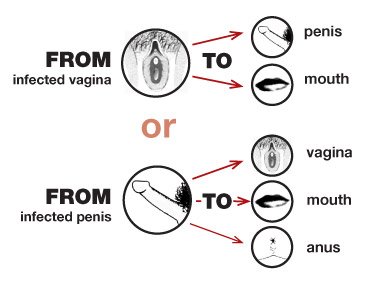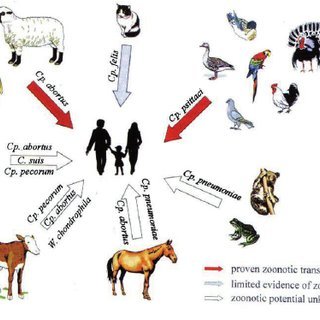How is Chlamydia contacted?
You can contact chlamydia only by direct contact of a mucous with the Chlamydia bacteria.

• Chlamydia can be gotten by sex: anal sex, oral sex or vaginal sex
• Infants contract chlamydia from infected mothers
• In rare cases, it can also come from animals.
Chlamydia contacted from sex.

Chlamydia contacted by oral sex
What is oral sex?
Oral sex is a sexual activity in which the mouth, lips or tongue are used to stimulate the penis; stimulating the vagina is known as fellatio; stimulating the penis is known as cunnilingus, and stimulating the anus is called aniling or rimming. Stimulating areas that surround the genitals with the mouth are also associated with oral sex.
What is the oral transmission process?
When an infected penis, vagina or anus comes into contact with the mouth, the mucous membrane secretions or semen infected with the chlamydia bacteria enter the mouth and affects the cell lining in the mouth and throat.
Chlamydia bacteria can still be transferred even if the penis or tongue does not penetrate fully into the vagina or anus. If the vagina, cervix, anus, penis or mouth comes into contact with infected fluids or secretions, transmission is possible.
Chlamydia contacted by anal sex
What is anal sex?
Anal sex is a sexual activity in which the penis is inserted into the anus. It is most commonly practiced in gay men. Women also practice anal sex with their partners.
What is the process of transmission through anal sex?
Chlamydia bacteria are transmitted from the penis to the anus or the anus to the penis.
This occurs when the moist lining (mucous membrane) in the rectum comes into contact with an infected penis or when an infected rectal mucosa comes in contact with the penis.
It can also be transmitted when a sexual tool (used for anal sex) that still contains remains of infected body fluid is used by another person immediately after use by an infected person.
Chlamydia contacted by vaginal sex
Vaginal sex is the conventional and preferred sexual method. This involves inserting the penis into the vagina.
What is the process of transmission through vaginal sex?
The infection is conveyed in the semen and vaginal fluids.
In women, the bacterium Chlamydia enters and infects the cervix (the passage between the vagina and the uterus). The infection, if left untreated, extends to the urethra (ureter), uterus (uterus) and fallopian tube.
In men, Chlamydia bacteria are transferred into the tip of the penis and infect the urethra and epididymis (the tube that carries sperm).
Ejaculation does not have to take place to become infected with chlamydia because it also spreads through contact with the mucous membrane in the genitals.
Contact of chlamydia from mother to infant during delivery

The Chlamydia bacterium is mainly transmitted to newborns when the baby is exposed to the vaginal flora of an infected mother during birth.
Caesarean section does not reduce the risk of a baby being infected with the bacteria.
The risk of transmission of chlamydia to a newborn by a mother is between 50% and 70%.
Chlamydia contacted from animals

This is a situation that occurs but rarely.
Chlamydia can be transferred between animals through sex or through contact with infected droppings or excreted fluid from the eyes.
Humans having sex with animals that recently had intercourse with another human, infected with the chlamydia bacteria, which still had remains of body fluids of the infected person, can spread the disease.
Humans can also get some strains of the chlamydia bacteria, from infected animals, through their droppings or body secretion.
Other means of transmission of Chlamydia bacteria
• Finger penetration can be used as a transmission medium. When a person touches the body fluid infected with Chlamydia bacteria and places it immediately in the genital area, the bacteria can be transmitted.
• When body fluids containing the bacteria come in contact with the eye, the eye can develop Chlamydia conjunctivitis.
• A woman who has her vagina infected with the chlamydia bacteria can spread it to her anus or rectum when cleaning with a toilet paper.
• Children can be infected if they are sexually abused by a person infected with the chlamydia bacteria.
• Using public toilets. In very rare cases, it is said that a man has a 5% chance of contacting the chlamydia infection, when his penis touches a freshly used toilet by an infected person. This is because the Chlamydia bacteria remain active until it dries up.
The next part will look at how to Know You Have Contacted Chlamydia .......